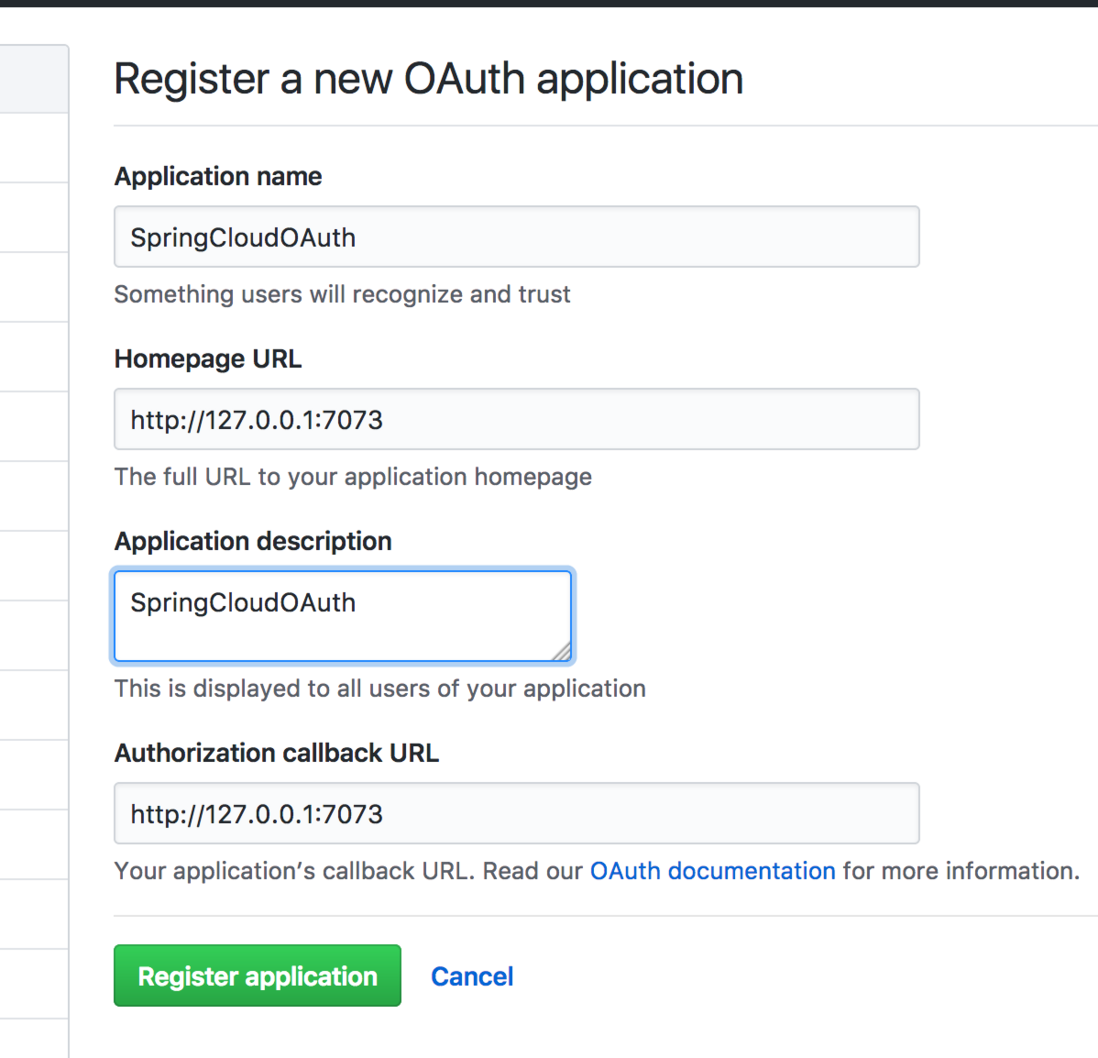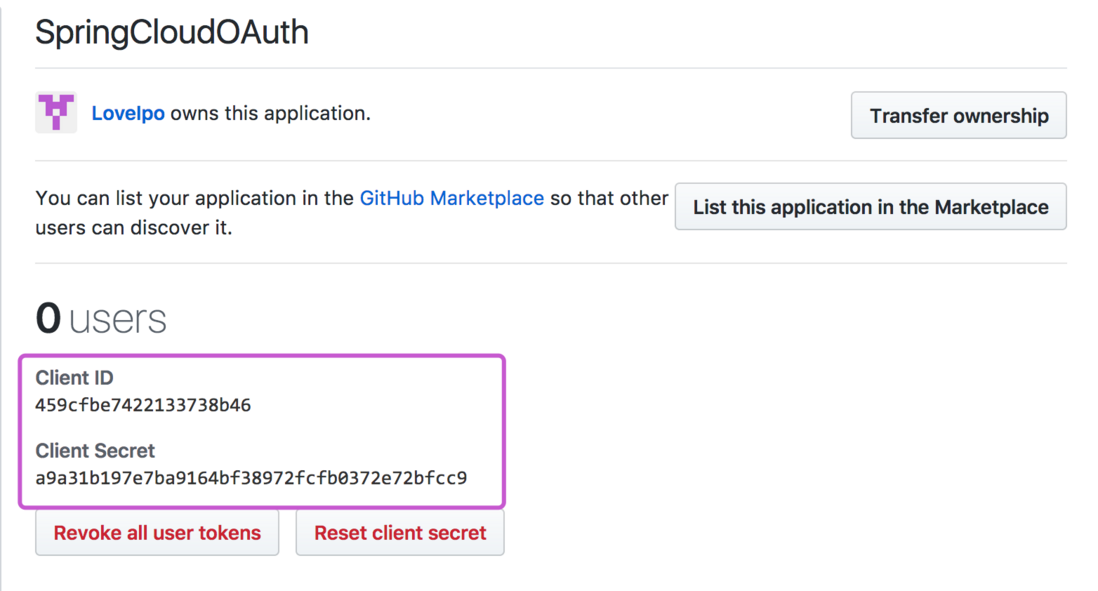一、前言
由于leader要求在搭好的spring cloud 框架中加入对微服务的认证包括单点登录认证,来确保系统的安全,所以研究了Spring Cloud Security这个组件。在前面搭好的demo中,如何确保微服务的安全,为整个系统添加安全控制,就需要用到Spring Cloud Security。用户通过服务网关zuul来访问任何一个微服务的时候,都需要跳转到第三方的认证比如github或者自己搭好的CAS单点登录服务,当认证通过才能访问对应的服务。在研究spring cloud security 之前先对一些概念进行了解了。
OAuth2(重点),参考文档:http://www.ruanyifeng.com/blog/2014/05/oauth_2_0.html
Spring Security OAuth2,参考文档:http://docs.spring.io/spring-boot/docs/1.5.2.RELEASE/reference/htmlsingle/#boot-features-security-oauth2
在这个文章中主要记录当用户通过服务网关zuul入口访问任何一个微服务。需要先跳转到GitHub,使用Github进行认证,认证通过之后才能跳转到访问我们提供的微服务。
二、详细实现
2.1 准备工作
(1) 前往https://github.com/settings/developers,点击“Register a new application”按钮,添加一个应用。点击按钮后,界面如下图所示。Homepage URL 和callback url是写zuul的端口。
(2) 点击“Register application”按钮,即可出现如下图的界面。
记住这边的Client ID以及Client Secret,后面有用。
至此,准备工作就完成了。
2.2 编码
代码测试成功之后的Github地址:https://github.com/LoveIpo/spring-cloud-demo/tree/master/Zuul_CAS这个Zuul_CAS是在zuul中进一步完善!
在这里,我们正式进行编码。因为我是在服务网关zuul中添加单点登录的服务认证授权。所以对前面demo中的zuul 工程进一步完善。
(1) 在pom.xml文件为应用添加spring-cloud-starter-oauth2、spring-cloud-starter-security两个依赖。
<dependencies>
<dependency>
<groupId>org.springframework.cloud</groupId>
<artifactId>spring-cloud-starter-zuul</artifactId>
</dependency>
<dependency>
<groupId>org.springframework.cloud</groupId>
<artifactId>spring-cloud-starter</artifactId>
</dependency>
<dependency>
<groupId>org.springframework.cloud</groupId>
<artifactId>spring-cloud-starter-eureka</artifactId>
</dependency>
<dependency>
<groupId>org.springframework.boot</groupId>
<artifactId>spring-boot-starter-test</artifactId>
<scope>test</scope>
</dependency>
<dependency>
<groupId>org.springframework.cloud</groupId>
<artifactId>spring-cloud-starter-oauth2</artifactId>
</dependency>
<dependency>
<groupId>org.springframework.cloud</groupId>
<artifactId>spring-cloud-starter-security</artifactId>
</dependency>
</dependencies>(2) 在zuul的启动类中添加如下代码
@SpringBootApplication
@EnableZuulProxy
@RestController
public class GatewayApplication {
public static void main(String[] args) {
SpringApplication.run(GatewayApplication.class, args);
}
@GetMapping("/")
public String welcome() {
return "welcome";
}
@RequestMapping("/user")
public Principal user(Principal user) {
return user;
}
@Component
@EnableOAuth2Sso // 实现基于OAuth2的单点登录,建议跟踪进代码阅读以下该注解的注释,很有用
public static class SecurityConfiguration extends WebSecurityConfigurerAdapter {
@Override
public void configure(HttpSecurity http) throws Exception {
http.
antMatcher("/**")
// 所有请求都得经过认证和授权
.authorizeRequests().anyRequest().authenticated()
.and().authorizeRequests().antMatchers("/","/anon").permitAll()
.and()
// 这里之所以要禁用csrf,是为了方便。
// 否则,退出链接必须要发送一个post请求,请求还得带csrf token
// 那样我还得写一个界面,发送post请求
.csrf().disable()
// 退出的URL是/logout
.logout().logoutUrl("/logout").permitAll()
// 退出成功后,跳转到/路径。
.logoutSuccessUrl("/login");
}
}
}
如代码所示,在这里,我们使用@EnableOAuth2Sso 注解,启用了“基于OAuth2的单点登录”,做了一些安全配置;同时,还定义了两个端点,/ 端点返回“welcome”字符串,/user 端点返回当前登录用户的认证信息。
这里说明一下,@EnableOAuth2Sso注解。如果WebSecurityConfigurerAdapter类上注释了@EnableOAuth2Sso注解,那么将会添加身份验证过滤器和身份验证入口。如果只有一个@EnableOAuth2Sso注解没有编写在WebSecurityConfigurerAdapter上,那么它将会为所有路径启用安全,并且会在基于HTTP Basic认证的安全链之前被添加。详见@EnableOAuth2Sso的注释。
(3) 修改zuul 的application.yml文件,部分代码如下
server:
port: 7073
security:
user:
password: user # 直接登录时的密码
ignored: /
sessions: never # session策略
oauth2:
sso:
loginPath: /login # 登录路径
client:
clientId: 你的clientId
clientSecret: 你的clientSecret
accessTokenUri: https://github.com/login/oauth/access_token
userAuthorizationUri: https://github.com/login/oauth/authorize
resource:
userInfoUri: https://api.github.com/user
preferTokenInfo: false
spring:
application:
name: zuul
eureka:
client:
serviceUrl:
defaultZone: http://localhost:7071/eureka/
这样,通过服务网关zuul来访问任何一个服务都要跳转到github进行认证的主要代码就编写完成了。
2.3 测试
(1) 启动Eureka、zuul、serviceA
(2) 当通过服务网关zuul(端口7073) 访问serviceA 的url:http://localhost:7073/api-a/add?a=111&b=113时。页面会自动跳转到github进行认证。
你也可以通过zuul访问serviceB也会自动跳转到github进行认证之后才能回调到serviceB。
(3) 当输入github的用户名和密码认证通过之后,会出现serviceA的调用结果。如下图所示
(4) 当你认证通过之后输入http://localhost:7073/user 可以看到你github 的用户信息。




**粗体** _斜体_ [链接](http://example.com) `代码` - 列表 > 引用。你还可以使用@来通知其他用户。